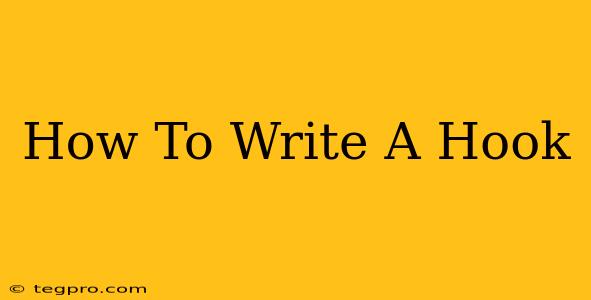Writing a compelling hook is crucial for any piece of writing, whether it's a blog post, novel, or even a tweet. A great hook immediately grabs the reader's attention and compels them to keep reading. Without a strong hook, your amazing content might never get the chance to shine. This guide will provide you with practical strategies to craft hooks that truly work.
Understanding the Power of the Hook
Before diving into techniques, let's understand why hooks are so important. Think of your hook as the bait on your fishing line. Without a tempting bait, you won't catch any fish (readers!). A strong hook accomplishes several key things:
- Captures Attention: It immediately pulls the reader in, preventing them from scrolling past.
- Creates Intrigue: It sparks curiosity and a desire to learn more.
- Sets the Tone: It establishes the overall style and voice of your writing.
- Establishes Relevance: It connects with the reader's interests and needs.
Types of Hooks: Finding the Perfect Fit
There's no one-size-fits-all approach to writing a hook. The best type will depend on your content, target audience, and desired effect. Here are some effective hook types:
1. The Question Hook
This classic approach uses a compelling question to engage the reader's curiosity. Make sure it's a question that genuinely piques their interest and leaves them wanting an answer.
- Example: "Are you tired of feeling overwhelmed by your to-do list?"
2. The Statistic Hook
Startling statistics can be incredibly effective. Use a surprising or relevant statistic to immediately grab the reader's attention and highlight the importance of your topic.
- Example: "Over 70% of people struggle with procrastination. Discover how to overcome it!"
3. The Anecdotal Hook
Begin with a short, captivating story or anecdote. This personalizes your writing and creates an immediate connection with the reader.
- Example: "I remember the day I realized I was drowning in debt... It was a turning point."
4. The Bold Statement Hook
Make a bold or controversial claim to instantly grab the reader's attention. Be prepared to back up your claim with strong evidence throughout your content.
- Example: "Marketing is dead. Here's why, and what you need to do instead."
5. The Problem/Solution Hook
Highlight a common problem your audience faces and offer a solution. This instantly makes your content relevant and valuable.
- Example: "Struggling to get a good night's sleep? These five tips will change your life."
Crafting the Perfect Hook: Practical Tips
No matter which type of hook you choose, remember these key tips:
- Keep it concise: Brevity is key. Your hook should be short, sweet, and to the point.
- Be specific: Avoid vague statements. Use clear and precise language.
- Target your audience: Tailor your hook to resonate with your specific readers.
- Maintain consistency: Ensure your hook aligns with the overall tone and message of your content.
- Test and refine: Experiment with different types of hooks and see what works best for your audience. Analyze your engagement metrics to optimize your approach.
Conclusion: Hook, Line, and Sinker
Mastering the art of writing a hook is a crucial skill for any writer. By understanding the different types of hooks and applying these practical tips, you can craft compelling introductions that capture your readers' attention and leave them eager to learn more. So, go ahead and start hooking your readers!

